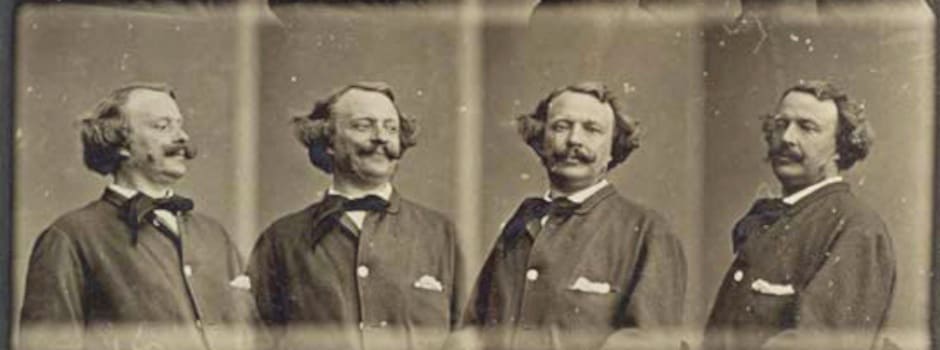Before the Camera Phone: Selfies Throughout History
The self-portrait isn't some millenial fad. It's a time-honored tradition.
 Credit:
Credit:
Recommendations are independently chosen by Reviewed's editors. Purchases made through the links below may earn us and our publishing partners a commission.
A few weeks ago, the Oxford Dictionaries named "selfie" the Word of the Year for 2013. Thanks to improved front-facing cameras on today's smartphones, the selfie boom has well and truly taken off, giving the average person the ability to selectively curate their own image and probably making the world far vainer in the process. But let's make no bones about it: Selfies are an ancient art form, going back centuries.
But it's not just that the selfie is old. Selfie culture is old. Self-portraits are one of the oldest forms of painting, and artists have been indulging in Photoshop-like effects for hundreds of years—bringing lazy eyes back to life or "forgetting" to include undesirable features like boils and scars. And while we think of them as recent innovations, we can find common selfie tropes such as the mirror shot, the fake candid, and the b-boy stance scattered throughout the history of self-recorded human images.
Today's selfie phenomenon is louder, crasser, and more in-your-face, but the base intentions are the same: fine art, vanity, the urge to leave one's mark on the world, and the desire to document ourselves doing cool stuff.
So let's take a look at some classic examples though the years, before the digital camera changed the game.
Jan Van Eyck and the Mirror (1434)
Paintings were the first selfies, and this — The Arnolfini Portrait — is likely one of the very first. In the beginning, artists would often insert themselves into a scene with others, instead of making themselves the sole subject of a work. While a cute, "meta" trick back then, this technique is often used by today's smartphone selfie fanatics to head off accusations of narcissism. In this particular tableau, the painter has subtly put himself in the mirror—a practice that would become far more common in the age of photography.
Robert Cornelius (1839)
Photography was invented in the late 1820s and early 1830s, and the earliest photographers didn't waste any time before turning the camera around to point it at themselves. This is the earliest known photographic selfie, as well as the first portrait of any human recorded on film. In unwittingly creating an entirely new genre, Cornelius established a few key precedents; the demure hand over the chest and his standoffish gaze would set the tone for most of the next two centuries, until the duck face invasion of the early 2000s.
Nadar (1865)
Photographer, artist, writer, and balloonist Nadar (a.k.a. Gaspard-Félix Tournachon) revolutionized the selfie (literally) with this photo booth–style series. With a contact sheet of various images, Nadar would have had many options from which to choose the perfect profile pic. The idea of snapping away until you get a shot that shows you in your best light might seem like a product of the digital age, but here's proof it happened on film too.
Émile Zola (C. 1900)
Émile Zola exchanged pen for camera in the late 19th century, taking his lifelike "naturalism" a step further. But his occasional self-portraits were the beginning of the de-monopolization of the selfie from pro photographer to the average Zo'. This selfie may also be the earliest iteration of the "b-boy" stance, popularized by hip-hop group Run D.M.C.
Anastasia (1914)
This 1914 selfie by the Grand Duchess Anastasia of Russia—yes, that Anastasia—was taken when she was about 13. Middle-schoolers would later become some of the most notorious selfie-takers.
Carl Van Vechten (1934)
Van Vechten, a noted American writer and photographer, took this selfie in 1934. With its crispness, the fact that both hands are visible, and Carl's apparent disregard for camera, it could pass for a candid if you saw it on your Twitter feed today. As this picture illustrates, the self-timer changed everything about the self-portrait game, even though it's rarely used today for selfies.
Stanley Kubrick (1940s)
This gem from Stanley Kubrick is an unabashed modern selfie from the 1940s, originally appearing in LOOK magazine. Using a mirror allows Kubrick to frame his shot perfectly, and the straight-ahead gaze indicates he doesn't feel any shame over taking a photo of himself. This is the same kind of selfie you'll see from enthusiast photographers and gearheads today, who are really just showing off their newest camera or lens.
George Harrison (1966)
The thinking man's favorite Beatle was extremely fond of selfies, taking them all over the world during the band's heyday. Our favorite is this 1966 shot from the Taj Mahal, where Harrison really got the most out of his circular fisheye lens.
It's a great choice if you want to get both yourself and a broad view of your surroundings into a shot. And, y'know... show off how awesome your life is. Ol' Georgie had a pretty awesome life, obviously.
Buzz Aldrin (1960s)
NASA's space projects are famous for their breathtaking photos. But when you're alone in space, or the only other person who could capture an incredible moment is sleeping, even astronauts have to be their own paparazzi.
But what makes Buzz different than the others is that he seemed to prefer selfies, occasionally taking them even when Neil and Michael were available. While the center image in this triptych shows Buzz reflected in Neil's visor, and the right image is clearly from an EVA, the left image was taken from inside the capsule, where he was not alone. That's taking the selfie to a whole 'nutha level.
Elvis Costello (1978)
This one could go many different ways, but let's be clear: This is not technically a selfie.
This album cover was staged and shot in a studio, and though it's not far off from Mr. Kubrick's candid selfie in composition, its intent could be very different. The album, after all, is called This Year's Model, and Elvis does look quite a bit like a fashion photographer.
But whatever the concept behind the shoot, the result looks exactly like a self-portrait. Add to that the fact that it's the album cover for his own record, and we think it's fair to call it a selfie in effect, if not execution. Perhaps this was the beginning of the ironic selfie?
The Selfies of the Future
Today, it can feel like the selfie has plateaued. Its ubiquity and stigma of vanity have led to a sense of selfie fatigue. Once the mainstream media gets ahold of a concept, after all, it's obviously dead.
But as this list ably demonstrates, the selfie has proven supremely adaptable to the times—it would be foolish to think we've seen the peak of self-portrait innovation. Even now, concepts like Snapchat are revolutionizing the way we interact with pictures of ourselves. Who knows what tomorrow's cameras will let us do with our own image?

